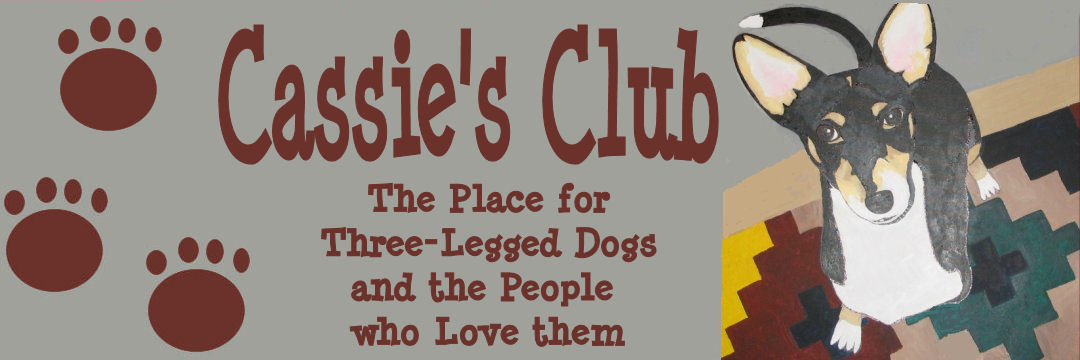|
|
|
Cassie's Club Members
|
| |


|
|
Red
Dear Cynthia,
I just found your website. We have a 6 year old Golden Retriever we adopted 3 months ago
who lost his left rear leg when he was 1 year old. I am noticing that by the end of the day
his back leg is sore (he hesitates to go up stairs and won't come up on the bed) and I'm worried
he may have long term issues with his remaining back leg if I don't educate myself about issues
3 legged dogs face with their remaining rear leg.
Your website is great - I read through some of the stories, but not all of them are specific
to my question of course. Any advice you have would be greatly appreciated!
Thanks!
Karen Pedersen
Tuesday August 9, 2005
Thanks for your reply. He is going into the vet next week just to get an overall plan
(food, supplements, exercise, etc) to best strengthen the remaining leg.
I'm curious, are there any of the stories on your website where people talk about how they
try and minimize leg soreness? I am starting to learn that consistent exercise is important
(vs. lots one day but none the next) along with keeping his weight lean, but I am sure there
are a lot of experienced people out there with great info to share on how they minimize
that soreness in the only rear leg. What I'm trying to get from other 3-legged owners
is mistakes they made that made the leg sore (are hills bad? good? long car rides make it sore?
things like that) and things that helped the soreness (massage, acupuncture, heat, cold, swimming,
etc.)
If you have seen any writings about that kind of stuff I would love to read them!
Thanks-
Karen
Wednesday August 10, 2005
To recap:
We recently adopted a golden retriever named Red. We adopted him from a golden retriever
rescue organization called Retrieve a Golden of Minnesota
and they are guessing he is 5 or 6 years old. At age 1 he was hit by a car and lost his
left rear leg. His owner said she didn't want him if they amputated his leg, so he was adopted
by a farm family. This family thought it was cruel to put him in their fenced in yard,
so let him run free. He was picked up along the highway every now and then, and last spring
he was impounded. When his family was told they had to pay $200 to get him out of the dog pound,
they said "forget it, we'll get another dog." Poor guy. He's the sweetest thing around,
and gets around quite well. At the end of the day he seems a little reluctant go up stairs
(although he still does it) so we are going to see our vet next week to get him a
food/exercise/supplement plan that will help his remaining leg remain as strong as possible.
I'm hoping that our 4 level house doesn't end up being an obstacle for him, because he would
be too hard to give up!
Wednesday August 10, 2005
***Hello, Cynthia, here.
To answer your questions,
If we had it to do all over again with Cassie, knowing what we now know,
we would never have walked her on hard concrete sidewalks or asphalt streets.
Hard, unforgiving surfaces are very high-impact to joints and bones.
We thought we were being responsible by scanning the ground 3 to 5 feet ahead of her
so she wouldn't hop onto broken glass, jagged metal and whatever else people
carelessly throw from cars, but now we think the high impact stress may have
prematurely brought on her arthritis and joint pain. We've had her on "Bute"
for several years now to help ease the pain. One 100mg tablet inside a
marble-sized ball of Velveeta cheese first thing in the morning seems to last all day
so she can still hop up and down the stairs. There are dog life preserver swim vests
in all sizes and colors that attach with velcro and have a handy carrying handle
built into the back to bring the dog back when he/she gets tired of swimming.
We strongly recommend water therapy because this is low to no impact on the joints
and bones. As for walking, Cassie is pretty much exclusively only on grassy areas now.
Because her mind still very much wants to see the sights and smell the smells of downtown,
we bought her a 2-kid jogger/bike trailer to wheel her downtown in.
She jumps out and back in on her own terms, walking around sniffing, checking everything out
as much as she is able. Hills are physically harder for everyone, dogs included,
and on long car rides they'd probably enjoy breaks to stretch their legs
just like we humans do. Dogs, just like people, are individual and unique.
Some have lots of energy while others are a bit lethargic (couch potatoes).
Proper weight management is very important, especially for those missing a front leg
because the bulk of the animal's weight is up front in the chest cavity
housing all internal organs. Having fewer legs to bear more weight adds unnecessary stress
and may well promote the toes to splay out farther and faster as they are burdened with
additional weight.***
|
| |

|
|
Maggie Mae
My name is Coreen and I volunteer with Eskie Rescuers United,
a national breed rescue for American Eskimo dogs.
I lost my older female Eskie in April this year, and wanted to bring another,
younger female into my home to keep companion to my 10-year-old boy Eskie.
Just about the time I lost my older eskie "Precious," a small young female Eskie
showed up in a Tennessee shelter, very broken and ready to be put to sleep.
It was suspected that she was dumped or hit by a car, as she was dragging a
nerve-damaged front leg and was showing signs of blindness and facial road rash.
She was pulled just in the nick of time by a rescuer, who took her to the
Tennessee chapter of Eskie Rescuers United. Through ERU, she had her
front right leg amputated, and her eyes were diagnosed with bilateral cateracts.
Because I have worked part time at a veterinary emergency service for several years,
and that I just began employment in July at the University of Pennsylvania Vet School,
I guess I was a logical choice to take "Ms. Magoo," the tripod, blind eskie puppy.
Precious was mostly blind with panuveitis for most of her life,
so I wasn't too concerned about that... but a front leg missing?
I was daunted by the thought of this!
Ms. Magoo (I have renamed her Maggie Mae) came to live with me
just this past Saturday, and boy is she a rough and tumble kind of kid!
She's really testing the pack hierarchy, and is just learning to use her
front left leg to balance her whole front end. Her body is very long,
so she tends to LUMBER more than hop, and is still tiring very easily
after only a few romps...but boy can she romp! Her toes seem to be "webbing"
in the front, moreso than in the back.
Maggie has a challenging life ahead of her, but I suspect she doesn't even know it!
I wanted to say thanks to this group/website for being present.
There isn't much information about front leg amputation on the web site,
and I am thrilled to have stumbled upon you folks tonight.
I am interested in hearing about ideas about walking 3-legged dogs,
thoughts regarding stairs, and if anyone has thoughts on PT to strengthen the front
remaining leg.
Here is 2-year old Maggie Mae (right) with 10-year old Cheyenne (left).
Look at those ears -- they really weigh down the front end!
Coreen + Cheyenne + Maggie Mae
Tuesday August 9, 2005
|
| |
|
< < Previous Page
Next Page > >
|
|



